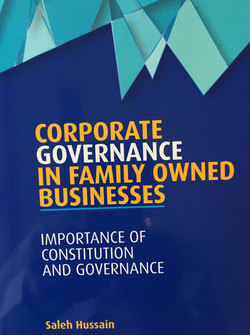Читать книгу Corporate Governance in Family Owned Businesses - Saleh Hussain - Страница 6
На сайте Литреса книга снята с продажи.
Chapter 2 Family Owned Businesses – Facts and Characteristics 2.1. Family Owned Businesses Worldwide
ОглавлениеFamily-owned businesses “FOBs” represent more than 80% of the total number of companies in any one country in the world. It is estimated, as contained in The Hawkamah Journal, Issue 1/2014, that collectively they generate between 70% and 90% of global GDP. In addition, these businesses and their owners control differing stakes in other commercial companies in any country. Therefore, the weight that FOBs carry in the economies of the world is enormous.
Furthermore, the global corporate stage provides FOBs with unlimited opportunities to expand their presence and associations. They play a major role in the key sectors of any economy.
% of FOBs in the GDP of stated Regions
a.Al Masah Capital Management Ltd., publication titled “MENA family businesses: The real Power Brokers (2012)”, gives below a table with some of large FOBs across the globe:
| Company | Family Name | Region |
| Wal-Mart Stores Inc. | Walton | North America |
| Ford Motor Company | Ford | North America |
| Carrefour Group | Defforey | Europe |
| PSA Peugeot Citroen | Peugeot | Europe |
| The Kharif Group | AlKharif | Middle East |
| Majid AlFottaim Group | AlFottaim | Middle East |
| Toyota Motor Corp | Toyota | Asia |
| Samsung | Lee | Asia |
They further state that only 48% of the FOBs make it to the first generation, 73% of the 48% make it to the second generation and only 20% of the 48% make it to the third generation. (EY survey).
b.Importance of Family Business:
c.Family Firm Institute Inc.(website:www.ffi.org/globaldatapoints), gave following statistics from around the world:
-Family firms account for 2/3rds of all businesses around the world
-70%-90% of GDP of the world is created by FOBs
-FOBs provide 50% - 80% of jobs worldwide
-85% of starts up companies are established by FOBs.
d.International Studies: Several years ago, researchers David Sirmon and Michael Hitt examined the strategies behind successful family businesses. They found that success is tied directly to how well a company manages the five unique resources every family business possesses:
i.Human capital. The first resource is the family's human capital, or "inner circle." When the skill sets of different family members are coordinated as a complementary cache of knowledge, with a clear division of labor, the likelihood of success improves significantly.
ii.Social capital. The family members bring valuable social capital to the business in the form of networking and other external relationships that complement the insiders' skill sets.
iii.Patient financial capital. The family firm typically has patient financial capital in the form of both equity and debt financing from family members. The family relationship between the investors and the managers reduces the threat of liquidation.
iv.Survivability capital. The family company must manage its survivability capital-family members' willingness to provide free labor or emergency loans so the venture doesn't fail.
v.Lower costs of governance. The family business must manage its ability to hold down the costs of governance. In non-family firms, these include costs for things such as special accounting systems, security systems, policy manuals, legal documents and other mechanisms to reduce theft and monitor employees' work habits. The family firm can minimize or eliminate these costs because employees and managers are related and trust each other. Clearly delineating these unique family resources and leveraging them into a well-coordinated management strategy greatly improves your business's chances of success compared to nonfamily-owned companies.
e.Family Business, first edition by Ernesto J Poze, in a presentation (2014) titled “Family Business: what makes it Unique?”, gives the following statistics:
-Constitute 80-90% of Businesses in USA and other free economies.
-Generate 49% of GDP in USA and more than 75% in most other countries.
-Employ 59% of private sector USA workforce and more than 85% of working population overseas.
-Created more than 80% of all new jobs in the 1980s and 1990s.
-Between 17 and 22 million family owned businesses in USA.
-Annual revenues exceeded $25million for 35000 family businesses.
-FOBs comprise: 37% of all fortune 500 companies and 60% of all publicly held companies.
f.Barbara R Hauser, in her valuable book “International Family Governance” (p:vii) states the following:
-“Proactive family governance can strengthen a family and enable it to weather the storms and to survive past the three generation cycle of failure”.
-“Proactive family governance can also promote peaceful and productive growth for the family and each of its members”
